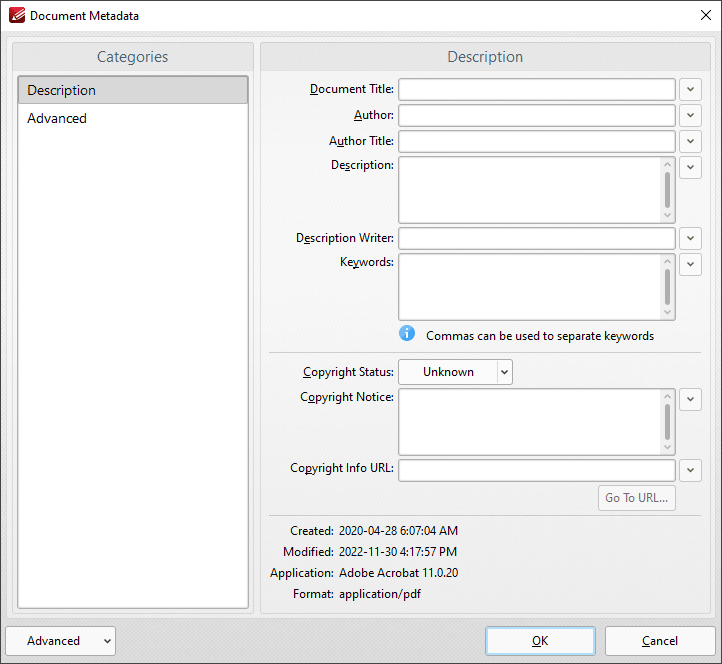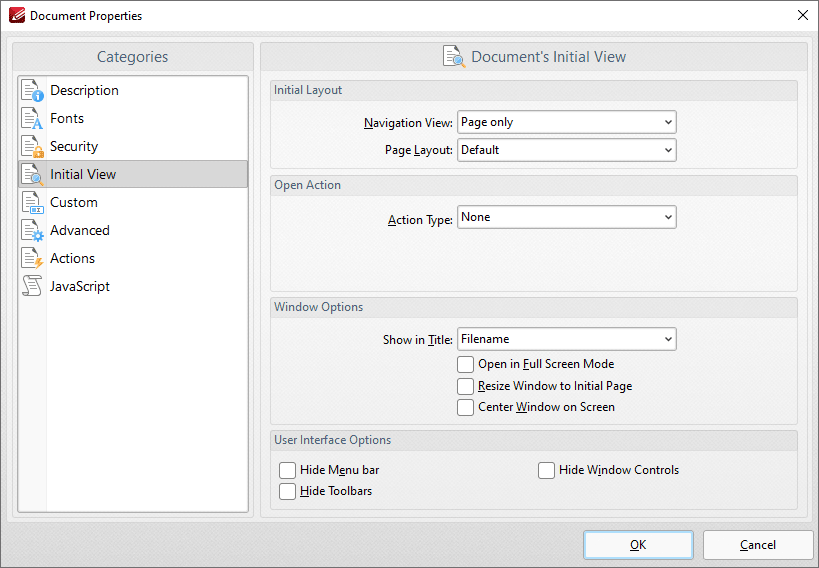 Document Properties
Document Properties
Click Document Properties to view/edit document properties:
Figure 1. File Tab Submenu, Document Properties
The Document Properties dialog box will open:

Figure 2. Document Properties Dialog Box, Description Option Selected
Please note that the keyboard shortcut Ctrl+D can also be used to launch this dialog box. Select an option from the Categories menu to view/edit properties:
Description
This option displays details about the current document:
•The File Info section contains information about the file name, location and size. Click the folder icon on the right to open the containing folder on the desktop.
•The Document Info section contains information about the Document Title, Author, Subject and Keywords. These can be edited using the adjacent text boxes. Further document details can be viewed beneath this section. Click the Additional Metadata button to view/edit additional document details:

Figure 3. Document Metadata Dialog Box, Description Tab
•Use the text boxes to view/edit document metadata.
•Click Advanced in the Categories menu to view the metadata structure of the document, as detailed below.
•Use the options in the Advanced dropdown menu to save the metadata template of the document or show the templates folder on the local machine.

Figure 4. Document Metadata Dialog Box, Advanced Tab
Existing document metadata is detailed in the pane on the right. Click options in the dialog box to Replace, Append, Save, Delete or Remove All document metadata as desired.
Fonts
This option displays details about document fonts. Please note that the information displayed is read-only. The Save as Optimized settings can be used to customize font embedding options.
This option displays document security details:

Figure 5. Document Properties Dialog Box, Security Option Selected
•Use the Security Method menu to select the type of security used in the document:
•No Security is the default setting, which means subsequent users have no restrictions on editing the document. This option should also be used when removing security from documents.
•Password Security enables document encryption, passwords and permissions. When it is selected the dialog box in (figure 6) will open.
•The Certificate Security option is available only when documents feature certificate security.
•The Microsoft Azure Information Protection option is available only when documents feature Microsoft Azure security.
•The FileOpen option is available only when documents feature FileOpen security.
•Click the Apply Security Policy button to apply a new security policy or clone/edit existing policies, as detailed in (figure 7).
•Additional security options are available here.
Click OK to save settings.

Figure 6. Password Security Settings
•Use the Compatibility menu to set the document security compatibility.
•Select an encryption option button to determine which elements of documents are encrypted.
•Select the Require password to open the document box to set a password for opening the document. Enter the password in the Document Open Password text box and confirm it in the text box below.
•Select the Restrict editing and printing of the document box to set a password for editing and printing the document. Enter the password in the Change Permissions Password text box and confirm it in the text box below. Use the dropdown menus and check boxes in the Permissions section to select the settings that these passwords will enable.
Click OK to save settings.

Figure 7. Managing Security Policies Dialog Box
This dialog box is used to create and manage security policies:
•Click Add New to add a new security policy. The Password Security Settings dialog box detailed in (figure 6) will open. Determine parameters as desired then click OK to save.
•Click Clone/Edit/Rename/Delete to perform these operations on selected security policies.
•Click Export to export the security policy for subsequent use. Exported polices can be imported with the Import button, which is on the right of the Export button.
•Click Apply to Document to apply the security policy selected in the Managing Security Policies dialog box to the current document.
These settings determine the layout when files are opened:

Figure 8. Document Properties Dialog Box, Initial View Option Selected
The Initial View settings are as follows:
•The Navigation View menu determines the panes that are visible when documents are opened:
•Select Default to retain the default settings of the application used to open documents.
•Select Page Only to view only the document itself.
•Select Bookmarks pane and page to view the document and the bookmarks pane.
•Select Thumbnails pane and page to view the document and the thumbnails pane.
•Select Layers pane and page to view the document and the layers pane.
•Select Attachments pane and page to view the document and the attachments pane.
•The Page Layout menu determines the page layout when documents are opened:
•Select Default to retain the default settings of the application used to open documents.
•Select Single Page to view a single page at a time.
•Select Continuous to view pages in a single, scrolling column.
•Select Two Pages Continuous to view two pages at a time in scrolling columns.
•Select Two Pages Continuous, with Cover Page to view as above, but with a cover page included.
•Select Two Pages to view two pages at a time.
•Select Two Pages with Cover Page to view as above, but with a cover page included.
•The Action Type menu determines the action performed when documents are opened:
•Select None for no action to be performed when documents are opened.
•Select Goto Page to open documents to a specific page. When this option is selected, the Open to Page and Magnification dropdown menus will become available. Select options in those menu to determine the page at which documents are opened, and the type of magnification used. The Magnification options are detailed below:
•Select Default to retain the default settings of the application used to open documents.
•Select Actual Size to view pages at their actual size. The resulting display will include resolution settings.
•Select Fit Page to view the full extent of page content regardless of its size.
•Select Fit Width to fit pages according to their width.
•Select Fit Height to fit pages according to their height.
•Select Fit Visible to view the entire page within the confines of the viewing area.
•Alternatively, select an option from the list of numerical percentages to determine the magnification level.
The Window Options are as follows:
•Show in Title determines the name displayed in the document tab when documents are opened. The options are File Name or Document Title.
•Select the Open in Full Screen Mode box to open documents in full screen mode.
•Select the Resize Window to Initial Page box to resize the viewing window according to the dimensions of the first page of the document.
•Select the Center Window on Screen box to center the viewing window on the monitor screen.
The User Interface Options are as follows:
•Select the Hide Menu Bar box to hide the Menu toolbar when documents are opened.
•Select the Hide Window Controls box to hide windows controls when documents are opened.
•Select the Hide Toolbars box to hide toolbars when documents are opened.
Click OK to save settings.
Custom
These settings determine custom document properties:

Figure 9. Document Properties Dialog Box, Custom Option Selected
•Click Add to add custom document properties to documents. The Custom Document Property dialog box will open. Enter a name and value for the property, then click OK to create it.
•Click Edit to edit selected custom document properties.
•Click Delete to delete selected custom document properties.
•Click Remove All to remove all custom document properties.
These settings determine advanced document properties:

Figure 10. Document Properties Dialog Box, Advanced Option Selected
•The PDF Settings feature two parameters:
•Enter a URL in the Base URL text box to specify a base URL for weblinks in documents. The option is included to simplify the management of web links to an external website. If the URL to the external site changes then this setting can be used to avoid having to edit manually every link in documents that refer to the external site. (Please note that the base URL is not used if a link contains a complete URL address).
•The Trapped option determines trapping options with regard to printing. This is a complex process that aims to optimize the quality of printed documents. See here for further details.
•Select the Print Dialog Presets box to override the viewing application's default print settings with those specified within the file itself:
•Select an option in the Page Scaling dropdown menu to determine the page scaling used:
•Default retains the default settings.
•None disables page scaling.
•Select an option in the Duplex Mode dropdown menu to determine the default duplex mode for printing.
•Select the Paper Size by document Page Size box to use the size of the document pages to determine the paper size of the document.
•Enter the pages to be printed in the Print Page Range text box. Further information on the specification of page ranges is available here.
•Use the Number of Copies dropdown menu to determine how many copies of the document are printed.
•Select the Reading Options box to enable binding and language options:
•Select either Left to Right or Right to Left as the document Binding option.
•Select an option in the Language dropdown menu to determine the language of the document.
These settings enable the activation of JavaScript commands when documents close/save/print:

Figure 11. Document Properties Dialog Box, Actions Option Selected
These settings can be used to enable JavaScript commands when the following operations take place:
•Before Document Close
•Before Document Saving
•After Document Saving
•Before Document Printing
•After Document Printing
Double-click the text box beneath operations to add JavaScript, as detailed here.
Click OK to save settings.
This option details JavaScript in the active document:

Figure 12. Document Properties Dialog Box, JavaScript Option Selected
JavaScript is a high-level programming language that can be used to perform a range of operations. Click Add, Edit or Delete to add/edit/delete JavaScript. See here for an index of existing JavaScript operations that PDF-XChange Editor supports and additional information about JavaScript.
